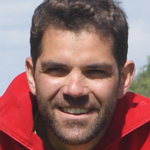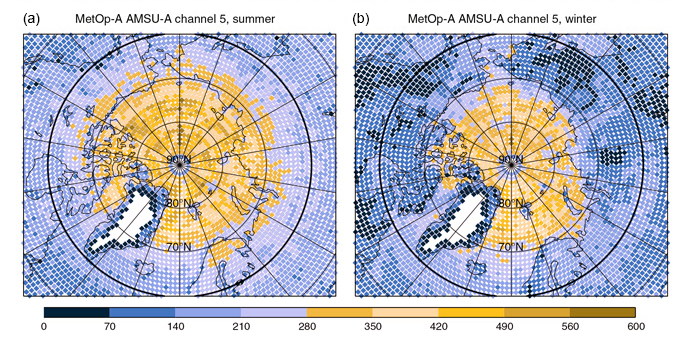 |
 |
Irina Sandu, ECMWF Physical Processes Team Leader, and François Massonnet, F.R.S.-FNRS Research Associate at the Université Catholique de Louvain (UCLouvain), Belgium
Polar regions have received increased attention in recent years, due in great part to the dramatic changes observed in these regions – just think for example of the pronounced Arctic warming and sea ice decline in recent years (Figure 1)!
Clearly, it is becoming more pressing than ever to improve both predictive skill and monitoring capabilities in polar regions and we highlight some relevant scientific developments in this blog. Furthermore, we are calling for contributions to a special collection in QJRMS to gather studies highlighting the impact of polar observations on predictive skill in polar regions and beyond.

Figure 1: Arctic sea ice extent (1979–2020) estimated from passive microwave satellite observations. Coloring is done according to the value of the minimum sea ice extent for each year. Data source: National Snow and Ice Data Center Sea Ice Index.
A commonly made – and yet incorrect – assumption is that polar regions are void of observations. It is true that conventional observations are sparser north of the 70°N parallel than south of it, for example. Conventional observations include: those gathered by national meteorological services through radiosonde launches, surface observations or deployment of buoys in the ocean or over the sea ice.
However, in terms of sounding satellite data, polar regions are sampled at higher temporal frequency than any other region on the globe, thanks to the fact that Low Earth Orbit (or polar-orbiting) satellites pass over the pole at each orbit. For example, the number of observations assimilated in the ECMWF Integrated Forecasting System in a period of 12 hours from one of these satellites is up to 8 to 10 times larger north of 70°N than in the mid-latitudes. For channels peaking in the stratosphere, the difference is even more striking.

Figure 2: Number of observations assimilated in the ECMWF operational forecasting system from MetOp‐A AMSU‐A channel 5 (peaking around 850 hPa) in (a) June–September 2016 and (b) December 2017 to March 2018. Note that 60°N is indicated as a solid black line. Adapted from Lawrence et al. (2019).
Observations are a key ingredient for accurate predictions from hours to years ahead. They are used in numerical weather prediction (NWP) systems to create the initial conditions for weather forecasts, using data assimilation techniques which blend observations and models to create the best possible reconstruction of the current state of the Earth system (the analysis, or reanalysis when we talk about past states).
With the ever-growing interest in polar regions, several questions related to the role of polar observations for predictive skill naturally arise and beg to be answered, such as:
- How much do current polar observations contribute to predictive skill from hours to years ahead?
- Do we make the best use of the current observations in polar regions?
- What new observations would we need to further enhance predictive skill in polar regions and beyond?
- What should future polar observing systems look like?
Coordinated numerical experimentation
These questions were recently thoroughly explored in the H2020 APPLICATE project and in the framework of the World Meteorological Organization's (WMO) Polar Prediction Project (PPP).
A community effort was made to understand the role of existing polar observations and how to maximise their use in numerical weather and climate prediction systems, and also to guide the design of future observing systems in polar regions. This effort relied on coordinated numerical experimentation with state-of-the-art prediction systems.
This experimentation focused on two aspects:
- the impact of atmospheric observations on short- and medium-range weather forecasts (hours to days); and
- the impact of sea ice initialisation on predictions a few months ahead (weeks to months).
The impact of atmospheric observations on short- and medium-range weather forecasts
Observing system experiments (OSEs) were carried out in which certain atmospheric observations in polar regions are withdrawn (denied) from the data assimilation process when creating the initial conditions for weather forecasts.
These OSEs, coordinated in the framework of PPP and APPLICATE, were performed at several operational weather centres, including ECMWF, Environment and Climate Change Canada (ECCC), the German Weather Service (DWD) and Met Norway. This helped us understand the impact of Arctic observations in different forecasting systems.
These OSEs covered the special observing periods of WMO’s Year of Polar Prediction (YOPP) and the analysis focused mainly on the impact of Arctic observations. The results highlighted the value of Arctic observations for short- and medium-range forecast skill, showing that:
- In global NWP systems, all current Arctic atmospheric observing systems increase short- and medium-range predictive skill both in polar regions and mid-latitudes.
- In all global NWP systems, conventional Arctic observations play the biggest role in winter, while in summer the leading observing system varies from one forecasting system to another. Radiances from microwave sounders play the biggest role in the ECMWF forecasting system, while conventional observations are most important at ECCC and DWD. This demonstrates that observation impacts are always subject to how the data are used in the NWP system.
- In regional NWP systems, like AROME-Arctic, there is a clear benefit in terms of short-range forecast skill from the assimilation of Arctic atmospheric observations both in the global models used to create their lateral boundary conditions, and in regional NWP systems themselves.
- The use of microwave sounder observations is sub-optimal during winter, particularly over snow and sea ice. Figure 2 illustrates that, in the lower troposphere, far fewer microwave observations are assimilated during winter than during summer in the ECMWF system, in particular in regions covered by snow and sea ice. In these conditions many observations differ too much from the short-range forecasts and hence are not used in the data assimilation system. This is because forecast errors are larger, and observation operators are incomplete or have larger errors than in other conditions (e.g. over the ocean or during summer). The strong positive impact of microwave observations on predictive skill in summer suggests that improving their use over snow and sea ice is likely to further improve forecasts in the Arctic and mid-latitudes.
The impact of sea ice initialisation on predictions a few months ahead (weeks to months)
Based upon a range of methods, from numerical experimentation with various modelling systems to analysis of state-of-the-art datasets (such as climate reanalyses), work done in APPLICATE has highlighted that satellite observations of sea ice are not optimally used either.
For example, Arctic sea ice reanalyses are well constrained when it comes to their areal extent, because large-scale concentration of sea ice is easily assimilated in models; but are highly scattered for thickness which is not yet routinely assimilated. Recent work has demonstrated the benefit of assimilating sea ice thickness information for seasonal Arctic sea ice predictions.
Changes in sea ice thickness have larger spatial coherence, so a limited number of well-placed in-situ monitoring stations could be sufficient to estimate the large-scale changes in sea ice thickness and volume at interannual time scales, especially if this new data is complemented by improving existing satellite retrievals for which large uncertainties remain.
Synergistic investments in observing and numerical prediction systems is key
The efforts led in APPLICATE and the Polar Prediction Project demonstrated that numerical models can be successfully used to:
- demonstrate the impact of current observing systems on predictive skill,
- identify ways to maximise their uptake in NWP systems, and
- guide the design of future observing systems, along the ideas exposed at the onset of WMO’s PPP and in a recent review paper.
The clear message is that investment in observing systems must be carried out synergistically with the investment in numerical prediction systems.
Investment in prediction systems (coupled modelling, use of observations, data assimilation and ensemble prediction techniques) may be at least as important as investments in observations themselves, in particular in polar regions which face specific challenges in each of these aspects. These challenges limit the extent to which satellite observations can contribute to creating accurate initial conditions for weather forecasts, as well as an accurate, consistent and comprehensive depiction of past conditions through long-term reanalyses.
For example, the suboptimal use of microwave observations is possibly related to:
- issues in the modelling of snow, sea ice, mixed-phase clouds and shallow stable boundary layers,
- the assumptions regarding the surface emission and reflection over sea ice and snow, made in the radiative transfer computations used to project model variables into satellite observation space (radiances) and
- the associated specification of background error covariances which is important for the weights given to the observation and model fields in the data assimilation.
Increasing the uptake of satellite data over all surfaces (as well as in all-sky conditions) in the Integrated Forecasting System is one of the priorities highlighted in the recently approved ECMWF Strategy for 2021–2030. Improving the use of microwave data over snow and sea ice would, for example, also benefit future reanalyses such as those produced by the Copernicus Climate Change Service (ERA5, CARRA) for time periods as far back as 1979, when the first microwave sounding instrument was launched.
The topic of polar observing system design is triggering a lot of interest in the community, as shown by the various scientific articles (example 1, example 2), meetings, working groups and initiatives developed over recent years. Avenues to increase the uptake of polar observations in NWP systems continue to be explored.
Many of these issues were discussed in a session at the European Polar Science Week.
A special collection in the Quarterly Journal of the Royal Meteorological Society
In response to the pressing scientific questions highlighted, a special collection has now been opened in QJRMS to gather studies highlighting the impact of polar observations on predictive skill in polar regions and beyond, from weather to climate time scales.
The first two papers in this collection are summarising the results of the OSEs performed at ECMWF. This special issue also welcomes OSE studies covering longer time scales (e.g. those analysing the impact of degrading initial oceanic and/or sea ice initial conditions on the predictive skill at sub-seasonal to seasonal time scales), as well as studies that use numerical experimentation to explore the possible added value on predictive skill of recently available or hypothetical observations (for which instruments are not deployed yet).
Acknowledgements
Many colleagues from various institutions across the globe contributed to the work summarised in this blog. In particular we would like to thank Niels Bormann, Heather Lawrence, Leandro Ponsoni, Jonathan Day, Peter Bauer, Roger Randriamampianina, Stephane Laroche, Emmanuel Poan, Alexander Cress, Ed Blockley, Daniela Flocco, Ed Hawkins, François Montagner, Samantha Burgess, Jorn Kristiansen, Martin Vancoppenolle, Pablo Ortega, Juan Acosta, as well as Thomas Jung, the chair of WMO PPP.
Top banner image: Mike Watson Images/moodboard/Thinkstock
